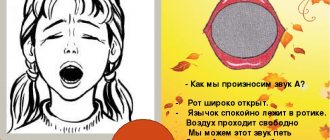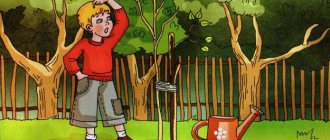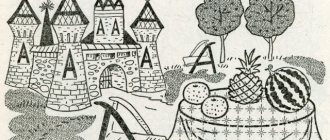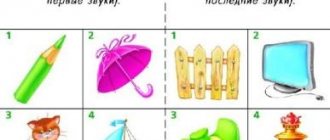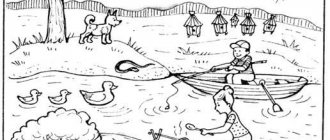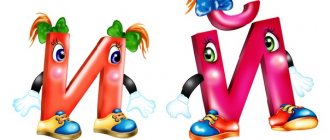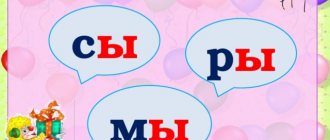Why is it difficult to growl?
The sound "r" is considered one of the most difficult to reproduce. To pronounce it correctly, you need:
- raise the tip of the tongue to the upper teeth - while it should remain spread out, like a pancake, and not narrow from tension;
- As you exhale, direct a powerful air stream to the tip so that vibration occurs.
For such manipulations, the child needs a developed speech apparatus, a strong tongue root and frenulum. Usually all this is formed by the age of six.
Automation of the sound [P] in words with consonant clusters
Game “Name the Object” Constellation of consonants -TR-
Spin the wheel. What happened? Don't forget to pronounce the [R] sound correctly.
Game "Anagram" Constellation of consonants -DR-
Make a word from the letters. Read what happened. Don't forget to pronounce the [R] sound correctly.
Game "Quiz" Consonant cluster -DR-
Guess what this is from the fragments? Read all the options. Choose the right one. Don't forget to pronounce the [R] sound correctly.
Game “How many syllables” Constellation of consonants -DR-
What is shown in the picture? How many syllables are there in this word? Choose the right one. Don't forget to pronounce the [R] sound correctly.
Game "Find the word"
Find words among the scattered letters in the square. They can be horizontal and vertical. Hold down the left mouse button and drag across the word. Watch the pronunciation of the sound [R].
What prevents you from pronouncing the letter “r” correctly?
Even with prepared instruments in their mouths, preschoolers manage to distort the ill-fated sound. And there are several reasons for this.
Short hypoglossal ligament
It is also called a bridle. It prevents you from moving your tongue freely and lifting it up. Most often, the problem is discovered in the maternity hospital. If the hyoid ligament does not allow the baby to suckle normally, it is cut. At a later age, the frenulum is usually stretched with the help of speech therapy exercises.
Phonemic hearing disorder
Phonemic hearing is the ability to correctly perceive and reproduce speech sounds. Normally, by the age of three, a child can already discern the difference between similar sounds, even if he does not know how to pronounce them.
Sometimes the development of phonemic hearing is delayed due to previous otitis media, adenoids or other health problems. As a result, sound analysis and synthesis are disrupted: the child hears the sound incorrectly, misses it in speech, or replaces it with another.
Incorrect speech breathing
To pronounce correctly, you need to be able to control your exhalation. Not all children succeed in this: some raise their shoulders while inhaling, others breathe too shallowly and unevenly, or do not know how to distribute the exhalation according to words.
Deep bite
With a correct bite, the upper front teeth overlap the lower ones by about a third, and the rest close together. But if the bite is too deep, the upper ones cover the lower ones by more than half. It becomes more difficult to achieve the correct position of the tongue with the emphasis on the upper teeth.
Card file of tasks for sound automation Card file for speech therapy (senior group)
File of tasks for audio automation R
Speech material in tasks is traditionally divided depending on the position of the automated sound in the word. The tasks can be used to develop phonemic awareness and expand the vocabulary of preschoolers. If the child does not have the sounds [S], [SH], [L] and others, it is not recommended to pronounce words with these sounds. In practice, speech therapists can vary the order of tasks.
LESSON 1.
1. Repeat the syllables:
| RA-RA-RA RU-RU-RU | RO-RO-RO RY-RY-RY |
| RA-RO-RU RO-RY-RA | RY-RU-RA RU-RA-RO |
2. Repeat the words:
| Cancer Work Radio Rana Rama Ranetka Rocket Paradise | mouth horns roses homeland Roma rota robot | fish fisherman lynx market dig jerk sob sob | hand sleeve handle chop shirt ore chopping plane |
3. “Big - small”
| Hand-handle Shirt-... Wound-... Mouth-... Roma-... | Fish-…. Rocket-... Rose-... Horns-... Paradise-... |
4. “Remember - repeat”:
| Cancer-Rana Rama-Raya Radio work Rocket-Ranetka | horn-horns mouth-ditch company-rose Motherland-Russia | fish-fisherman lynx-dig market-jerk jerk-lever | hand-sleeve handle-chopping ore-chopping chopping-plane |
5. Repeat the phrases:
| Pink roses. Raya has roses. Native home. Level moat. Different sleeves. Broken shell. | Different balls. The growl of a lynx. Timid Roma. Rosy roll. Fish market. Joyful parents. |
6. Repeat the sentences:
| Roma caught a fish. Rose tells a story. The workers were digging a ditch. Raya makes her parents happy. | Raya puts on her gloves. There is a work uniform in the locker. Raya grows roses. Roma has a mole. | The shirt has long sleeves. Roma will go to his relatives. Roma has a rocket. A worker goes to work. |
LESSON 2.
1. Repeat the syllables:
| AR-AR-AR UR-URUR IR-IR-IR | OR-OR-OR YR-YR-YR YAR-YAR-YAR |
| AR-OR-UR OR-YAR-IR | IR-AR-OR UR-YR-AR |
2. Repeat the words:
| Steam Dar Ball Impact Mosquito Tan Bar | choir bor fence ax choice motor set | feast world shooting kefir marshmallow uniform commander | wind evening master fan boat room tanker | hillock tomato fly agaric agreement rebuff pattern yard |
3. Repeat pairs of words:
| Khor-bor Ax-fence Motor-set Par-ball Impact-tan Product-bazaar | feast-world kefir-marshmallow wind-evening boat-room tomato-fly agaric yard-pattern |
4. Repeat pure sayings:
| OR-OR-OR - fly agaric in the field. AR-AR-AR - steam in the sky. UR-UR-UR – long cord. IR-IR-IR – Roma drinks kefir. | OR-OR-OR – the motor does not work. AR-AR-AR - a mosquito sits on your nose. UR-UR-UR – take the chickens away. IR-IR-IR - I want to see the world. |
5. Repeat the phrases:
| New fence. The choir sings. Raya has a tan. Home yard. Strong boxer. Poisonous fly agaric. To push back. I'll go to the market. | Delicious marshmallow. Russian cheese. Drink kefir. Buy a samovar. Fairy tale "Moidodyr". Number five. Embroider a pattern. I'll sweep the yard. |
6. Learn a tongue twister:
From behind the forest, from behind the mountains, Grandfather Egor is coming.
LESSON 3.
1. Repeat the words:
| Mountain Hole Ur Nora Cora It's time Ira | tara para headlight guitar Vera Kira Yura | kennel office game plywood panther kids heat | ram monitor lizard buran pirate parade karat marat | crow crown threshold cottage cheese lesson peas people | city sparrow round dance steamer hero road gate | pen lake bureau bucket morning core thigh |
2. Repeat pure sayings:
| Ra-ra-ra - thin bark. Ro-ro-ro-new feather. Ry-ry-ry - there are mosquitoes in the sky. Ru-ru-ru - the kangaroo jumps. | Ra-ra-ra is a high mountain. Ro-ro-ro - new bucket. Ry-ry-ry - let's buy balloons for everyone. Ru-ru-ru - I’ll pick a lot of berries. |
3. “Remember - repeat”:
| Bark-mountain-nora Hurray-it's time-game Headlight-para-guitar | Yura-Ira-Vera game-kennel-kids plywood-panther-office |
4. Repeat the phrases:
| Thin bark. There is a hole near the fence. Short pencil. Fragrant pie. Wide threshold. | The kids are coming. Smooth road. Hometown. Pink Panther. Old trough. | Old barn. Sharp axes. Expensive gift. Hoodie. Ruddy loaf. |
5. “One is many”
| Mountain-mountains Nora-nora Hole holes Par-pairs Mosquito-mosquitoes Bazaar-bazaars Headlights | pattern-patterns fly agaric-fly agarics ax-axes ball-balls blow-blows set-sets motors-motors |
6. Learn a tongue twister:
Tarara-tarara - get up, kids! Tarara-tarara - it's time to go to kindergarten! Tururu-tururu – raising the children. Tyryry-tyryry - there are no children at home.
LESSON 4.
1. Repeat the words:
| Drum Cockroach Caravan Hurricane | ant loaf veranda steering wheel | collar garden warts breed | piglet brushwood locomotive boletus | pyramid frost crown horoscope |
2. Finish the last syllable:
“RY” Moto..., zabo..., nabo..., pomido..., samova..., ouzo..., mundi..., sha..., pa....
“RA” But..., go..., pa..., ig..., detvo..., zha..., Yu..., I..., konu..., fa..., pante....
3. Repeat pure sayings:
| Ra-ra-ra - the game begins. Ro-ro-ro-we'll take the subway. Ry-ry-ry- ran to the mountain. Ru-ru-ru- I take a new pen. | Ra-ra-ra- spring time. Ra-ra-ra - it's time for me to go home. Ry-ry-ry - the mouse is sitting by the hole. Ru-ru-ru- rolled the ball into the hole. |
4. Repeat the sentences:
Marusya collects tomatoes. Roma collects peas. The road leads to the city. Raya has a new sundress. Tamara is baking a pie. Yura is not afraid of frost. The cow goes to the barn. The crow is pecking at the corn. They bought Roma a guitar. Pinocchio goes to class. There are a lot of kids on the ship.
5. Learn a tongue twister:
Early, early, in the morning the red kangaroo gallops.
LESSON 5.
1. Repeat the syllables:
| ARCA-ARCA-ARCA ORCA-ORCA-ORCA | URKA-URKA-URKA ARKA-URKA-ORKA |
2. Repeat the words:
| Arch Harp Map Mark Part March | pocket cardboard picture potatoes curtain accordion | slide mink crust spanking grater closet | farm willow tag company blizzard Murka | park mart port feed cake board | top carp coat of arms court horn mors |
3. Repeat the phrases:
| Old hill. Northern city. Mischievous sparrow. Short pile. A bright picture. Black cardboard. | Sea wind. Beautiful stamps. Royal coat of arms. Stainless jacket. Collect potatoes. Carrot juice. |
4. “Call me kindly”
| Cake - Mark's cake -... Desk -... Map -... | pocket -... accordion -... picture -... willow -... | Murka -... fruit drink -... scarf -... grain -... |
5. Learn tongue twisters:
Egorka the hare fell into the lake. Run down the hill, Save Yegorka!
On a black night, a black cat jumped into a black chimney.
LESSON 6.
1. Repeat the syllables:
| PRA-PRA-PRA PRO-PRO-PRO | PRU-PRU-PRU PRRU-PRRU-PRUR |
2. Repeat the words:
| Truth Right Holiday Correct Right Great-grandfather Practice Laundress | cork sample products millet simple wire sell passage | twig twig pond spring jump jump jumper jumper |
3. Repeat the syllables and words:
| BRA-BRA - marriage BRA-BRA - bravo BRA-BRA - take BRA-BRA - brother BRA-BRA - scolding BRA-BRA - cobra BRA-BRA - zebra | BRO-BRO - eyebrows BRO-BRO - throw BRO-BRO - ford BRO-BRO - wander BRO-BRO - throw BRO-BRO - bronze BRO-BRO - bronchitis |
| BRU-BRU – timber BRU-BRU – timber BRU-BRU – lingonberry | BRY-BRY - splatter BRY-BRY - splashes BRY-BRY - brynza BRY-BRY - beavers |
4. Repeat the phrases:
| Smooth bars. Roma has bronchitis. Brave officer. Bronze award. See your brother off. Splash in the pond. | Throwing a cork. Jump from the mountain. Elastic spring. A simple pencil. We saw a zebra and a cobra. Walk down the aisle. |
5. Learn a tongue twister:
All beavers are kind to their beavers.
LESSON 7.
1. Repeat the syllables:
| GRA-GRA-GRA GRO-GRO-GRO | GRU-GRU-GRU GRY-GRY-GRY | GRA-GRO-GRU-GRY GRO-GRY-GRA-GRO |
2. Repeat the words:
| Grad Grach Graf Gram Garnet Grenade Certificate | rake rooks decanter countess thermometer degrees border | thunder thunderstorm roar loud menacing cargo load | rude sad load pear group truck milk mushroom | rodent gnawing fence reward game photography toy |
3. Repeat the chain of words:
| Hail - gram - rook Thunder - roar - thunderstorm | cargo – load – truck gnaw – rodent – stub |
| Rake - pomegranate - diploma Loud - rude - sad | fence - reward - grenade pear - rooks - group |
4. Change the words according to the example:
| Pomegranate – pomegranate Pear – pear | volume - loud rudeness - rude | cargo - cargo group - group |
5. Repeat the sentences:
Loading pears into a truck. Thunder rumbles loudly. There is thunder and roar in the sky. Rodents gnaw the stub. The thermometer shows five degrees. They load the cargo loudly. There is a strong fence at the border. There is pear syrup in the decanter. Award with a certificate and award. There is loud laughter in the group. Buy a garnet bracelet.
6. Learn a tongue twister:
There's thunder and thunder in the sky, close your eyes. There is no thunder, the grass is shiny. There is a rainbow in the sky.
LESSON 8.
1.Repeat the syllables:
| KRA-KRA-KRA KRO-KRO-KRO | KRY-KRY-KRY KRU-KRU-KRU |
| KRA-KRA-KRO KRU-KRU-KRY | KRO-KRO-KRU KRY-KRY-KRA |
2. Repeat the words:
| Paint Crab Nettle Faucet Edge Beauty Red | mole blood blood crown baby cross rabbit | circle croup twist circle circle cool cool | cover cover rat roof cover wings Crimea |
3. “Call me kindly”
| Faucet - faucet Crab - crab Mole -... Circle -... Rat -... Roof -... Wings -... | porch -... sneakers -... paint -... mug -... nettle -... postcard -... okroshka -.... |
4. Repeat the phrases:
| Red sundress. Indoor market. Black paint. Open window. Beautiful rabbit. | Old photo. Sharp turn. Red line. Large gooseberry. Paint the roof. | Tiger Tamer. Beautiful coverage. Painted porch. Close the tap. Screw on the lid. |
5. Learn a tongue twister:
Yegor paints the roof and fence with red paint.
LESSON 9.
1. Repeat the words (words contain two R sounds):
| Horn Radar Garnish Tournament Fee Porcelain | farmer Aurora character tractor parting report | ice hole wardrobe fair taratorka marble apartment | marker partner resort surgeon test tube program | airport airfield sandwich whirlpool thermometer orchestra |
| Rupture Devastation Destruction Size Conversation | coloring solution constructor transformer tongue twister | space pressure cooker steamer losing supermarket | instructor horizon disassembly route loss |
2. Repeat the phrases:
| Loud shout. Competent instructor. Spacious apartment. The orchestra is playing. Bright coloring. Large supermarket. Urban transport. Huge size. Red solution. | Sandwich with red caviar. Broad outlook. Even parting. Beautiful fair. China. Evening program. Broken steamer. Difficult tongue twister. Short conversation. |
3. Learn tongue twisters:
Three magpies chattered on the hill. (A. Taraskin)
The crow missed the crow.
How to distort the letter "r"
On specialized resources Rotacism the following main variants of distortion of the sound “r”, or scientifically called rotacism, are described:
- Burr, or throaty “r”. It is not the tip of the tongue that vibrates, but the soft palate. This pronunciation is normal for French and German, but not for Russian speech.
- Lateral "r". One side of the tongue is pressed against the upper teeth, the other side hangs down, and the tip does not vibrate. The result is something similar to “rl”.
- Single-stroke "r". Instead of vibrating, the tip of the tongue hits the hard palate once, forming something like the English r.
- Nasal "r". When you exhale, the air flow does not pass through the mouth, but through the nose. In addition, the tip of the tongue is pulled back and does not participate in articulation. The phrase “Roma, open the doors!” will turn into “Ngoma, otkngoy dvengi!”
- Kuchersky "r". And again, the vibration occurs in the wrong place, namely on the lips close together. The baby makes something similar to “whoa.”
- Pararotacism, or replacement of “r” with another sound. Instead of “child” you hear “child”, “hebyonok”, “vebyonok”, “yaebyonok” or even “yebyonok”.
- Missing "r". The kid simply avoids difficulties. He says not “fish”, but “yba”, not “glad”, but “hell”, not “thunder”, but “gom”.
What exercises can you do at home?
Establishing the exact cause of rotacism and determining how to deal with it in your particular case is a task for a speech therapist. But if the child is not yet six or due to certain circumstances it is not yet possible to visit a specialist, you can try to curb the “r” yourself. To do this, you need to fulfill only three conditions.
- Have patience. The process is unlikely to be quick and the result easy. You may need months of daily practice.
- Prepare the place. Speech therapy exercises are best performed while sitting together in front of a large mirror. The baby needs to clearly see the movements of the mouth - yours and his own. Alternatively, sit opposite each other, but then your student should have a large table mirror.
- Get ready for the game. Although mastering the “r” is a serious matter, it is better to conduct classes in a playful way. Let the child perceive them as a reason to have fun with mom or dad, and not as a difficult and boring chore. In any case, training should take no more than 10–15 minutes a day, and even then with breaks.
Now let's move on to the exercises.
Articulation gymnastics
You need to start the lesson by warming up your speech apparatus. These exercises will warm up the muscles, strengthen the tongue and help stretch the hyoid frenulum.
Swing
We open our mouth wide and swing our tongue up and down, touching the upper and lower teeth. Then we hold the tip near the upper teeth for 15–20 seconds.
Cuckoo
The mouth is still wide open. We stick out the tip of our tongue and touch it to the upper lip, and then hide it behind the upper teeth.
Painter
We imagine that the tongue is a wide brush, and carefully “paint” the teeth, cheeks, and upper palate with it.
horse
We click our tongue on the upper palate, as if a horse’s hooves are clicking.
Treat
We lick our lips clockwise and counterclockwise with our tongue outstretched.
Kitty
Imagine that there is a treat on the saucer - jam or ice cream. Now you need to stick your tongue out as far as possible and lick the treat so that the tongue does not curl into a tube, but remains spread out.
Harmonic
We lift the tongue up and “glue” its tip to the palate. Now, without lifting your tongue, open and close your mouth.
Hammer
We stretch our mouth into a smile and tap the tip of our tongue on the base of the front teeth, as if we are hammering nails.
Exercises for making the sound “r”
To pronounce “r” correctly, you need to start with other sounds.
Drum
Open your mouth wide and hit the tip of your tongue behind your upper teeth, pronouncing the sound “d.” Slowly at first, then faster. And there it’s already not far from “r”.
Buzzer
We pronounce the sound “zh” and at the same time constantly pull the tip of the tongue deep into the mouth. Over time, the “zh” will turn into a weakly vibrating “r”.
Snake
We repeat the sound “s-s-s” several times, after which we swallow our tongue and touch the tip of our tongue to the roof of our mouth.
Turkey
We stick out our wide tongue and perform movements back and forth, sliding the tip along the hard palate. At the moment when the tongue touches the alveoli - the tubercles behind the upper teeth, a single-beat “r” is produced.
Komarik
Open your mouth wide, lift your tongue up and rest it on the alveoli. And now for 10-15 seconds I buzz energetically, like a mosquito.
Motor
Place your index finger or a cotton swab under your tongue and vigorously move it back and forth, while simultaneously performing the “Mosquito” exercise.
Consolidate the result
When the sound itself is already obtained, you need to bring its pronunciation to automaticity. To do this, after articulation gymnastics, instead of positioning exercises, perform a complex to consolidate the skill.
- We pronounce the letter “r” loudly and clearly several times.
- We practice “r” through the consonant sounds “d” and “t”: “dra-dro-dru”, “tra-tro-tru”.
- We remove the supporting “d” and “t” and work with “ra-ro-ru”.
- We move on to the reverse syllables “ar-or-ur”, as well as to the position of “r” between vowels - “oru-ura-ara”. We repeat these combinations in different combinations day after day until the child is able to pronounce “r” with vibration. Only then can you practice with words.
- First, we practice words that begin with “r” or even with “tr” and “dr” (grass, firewood, throne, drone, ladder, drape, hand, river, shirt). Then we take on nouns where “p” is in the middle or at the end (cow, great, carpet, fence, axe).
- We include sentences, rhymes and tongue twisters with the letter “r”.
Tasks with the letter P for preschoolers and 1st grade students
Author: Daria Gerasimova “The ABC of Transformations”
Letter P in the form of a robot. Author https://ninapushkova.blogspot.com
The material on the page is arranged from simple to complex. First, there are tasks for learning the letter and sound R for the little ones. Basically, these are primers where the child is given associations with the letter and sound [P] . For example, this is the letter P, with which the word CANCER begins. Find the letter R in these words. Here the child, relying on the example (a large blue letter), looks for the same letter in the words.
Letter P cards with pictures for study (cheese, crocodile, backpack, radish, comb, corn, shorts, pen).
To better remember the letter P, we use all channels of perception: visual, auditory, kinesthetic (we trace the letter with our finger). Next, the letters can be colored or shaded, thereby preparing the child’s hand for writing. We continue to work on the development of fine motor skills and memorization of the letter - we write the printed letters P according to the model.
Phonics analysis exercise prepares children for literacy learning. Below you need to determine the position of the sound [P] in words (picture, fish fence). An adult pronounces the sound R exaggeratedly (karrrrrtina), the child determines by ear the place of the sound in the word (at the beginning - the very first sound, in the middle, at the end - the very last sound) and graphically designates it in the diagram with a blue pencil (hard consonant sound).
Coloring page with the letter P
This is a favorite activity for children of all ages. You need to find all the P sounds in the picture and color them. The exercise is very motivating for children, even the laziest and most unwilling children do it with pleasure.
Next, you can ask the children to name all the objects shown in the picture with the sound P (tiger, trainer, top hat, wool, hands, mouth, pyramid, and so on). Then we determine the position of the sound in the words, make up sentences with these words, and use the picture to make a story.
Look at the drawing and name what you see. Find all the letters P in the picture and color them blue.
Oksana Gomzyak “I will write correctly. Album of exercises to prevent writing disorders in children of the preparatory group"
Colored ABC book for preschoolers. With its help, children will become familiar with the letter and sound [P], develop fine motor skills, attention, write and read syllables and words.
"A primer-copybook." Klimkina Yu.E., Solovyova S.A.
Author: I.I. Pilat, V.A. Knysh “LEARNING LETTERS BY PLAYING”
When to take your child to a speech therapist
It is advisable to do this before the baby goes to school. Otherwise, a problem with the pronunciation or perception of “r” may affect your studies or communication with peers.
How long will the correction take? Everything is very individual: for some, three or four sessions with a specialist are enough, while others need months of regular training at home under the supervision of a speech therapist. In any case, in adulthood, the process of correcting speech errors will require much more time and effort than at 6–7 years old.
Reading tasks with the letter P for preschoolers and first grade students
Source: Lyudmila Odnovol “Soon to school. Reading from A to Z"
Tasks for teaching literacy pictures with the sound R for preschoolers and primary schoolchildren. The work is carried out with words starting with the letter P at the beginning, in the middle and at the end of words for children in pictures.
Author of the manual: Kosenko Yu. A. “Learning to read and write”
Developmental tasks with the letter P for preschoolers. Here children find similarities and differences (development of attention, thinking), find hidden letters P in the picture, name the crossed out letters (visual gnosis), color daisies with the letter P written correctly.
Svetlana Yakovleva “I recognize letters - 1”

